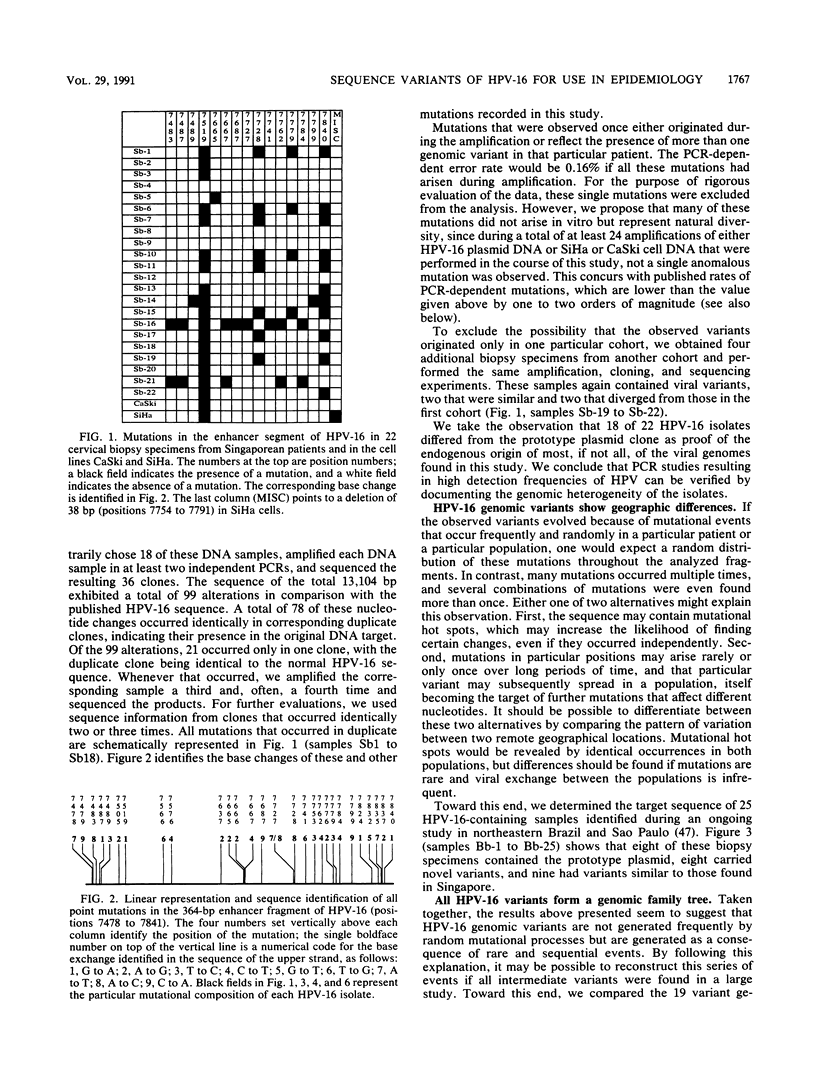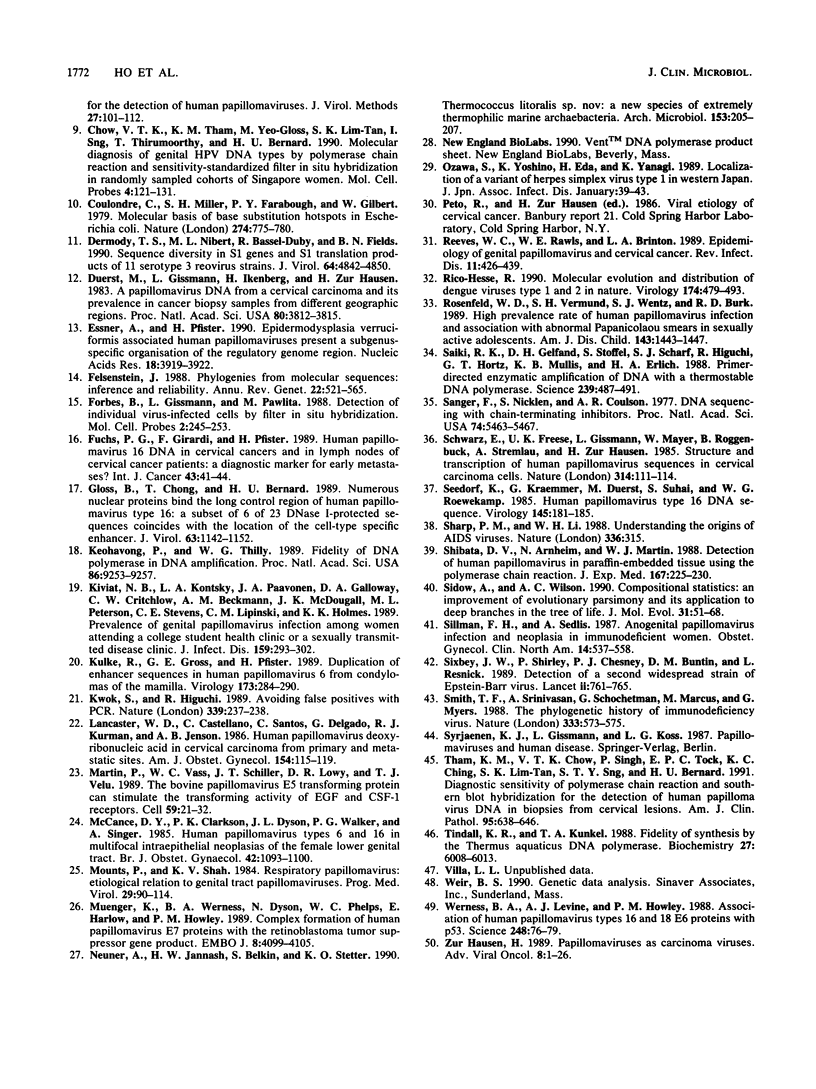Abstract
Genomic variability between different viral isolates provides a powerful epidemiological tool for verifying ultrasensitive diagnostic procedures, understanding infectious pathways in individuals and human populations, and studying viral evolution. The potential of this approach has not yet been exploited for the diagnosis of human papillomaviruses (HPVs) like HPV type 16 (HPV-16), which are involved in genital cancer. Toward this end, we amplified by polymerase chain reaction, cloned, and sequenced a 364-bp noncoding segment of the HPV-16 genome from cell lines, cervical biopsy specimens, and cervical smears. The HPV-16 genomes in the cell lines SiHa and CaSki showed an identical point mutation, and in the SiHa cell line it had an additional 38-bp deletion. Only 4 of 22 cervical lesions biopsied from patients at several hospitals in Singapore contained HPV-16 DNA with the prototype sequence, while the DNAs of the other 18 cervical lesions differed by 1 to 10 mutations. This excludes contaminations with cloned HPV-16 DNA as the source of this DNA. To test whether this diversity was a geographic idiosyncrasy, we analyzed 25 cervical biopsy specimens from Brazil. Eight of these contained the prototype sequence, while 17 were mutated. Altogether, 11 genomic variants were found in the Singaporean samples and 12 genomic variants were found in the Brazilian samples, and only 5 of these occurred identically in both cohorts. All variants could be connected to form a phylogenetic tree, with some branches being specific for each cohort. This suggests that the variants did not originate over a short period in the individual patient but, rather, evolved consecutively while spreading throughout humankind.(ABSTRACT TRUNCATED AT 250 WORDS)
Full text
PDF







Selected References
These references are in PubMed. This may not be the complete list of references from this article.
- Baker C. C., Phelps W. C., Lindgren V., Braun M. J., Gonda M. A., Howley P. M. Structural and transcriptional analysis of human papillomavirus type 16 sequences in cervical carcinoma cell lines. J Virol. 1987 Apr;61(4):962–971. doi: 10.1128/jvi.61.4.962-971.1987. [DOI] [PMC free article] [PubMed] [Google Scholar]
- Balfe P., Simmonds P., Ludlam C. A., Bishop J. O., Brown A. J. Concurrent evolution of human immunodeficiency virus type 1 in patients infected from the same source: rate of sequence change and low frequency of inactivating mutations. J Virol. 1990 Dec;64(12):6221–6233. doi: 10.1128/jvi.64.12.6221-6233.1990. [DOI] [PMC free article] [PubMed] [Google Scholar]
- Bevan I. S., Blomfield P. I., Johnson M. A., Woodman C. B., Young L. S. Oncogenic viruses and cervical cancer. Lancet. 1989 Apr 22;1(8643):907–908. doi: 10.1016/s0140-6736(89)92911-5. [DOI] [PubMed] [Google Scholar]
- Bilsel P. A., Nichol S. T. Polymerase errors accumulating during natural evolution of the glycoprotein gene of vesicular stomatitis virus Indiana serotype isolates. J Virol. 1990 Oct;64(10):4873–4883. doi: 10.1128/jvi.64.10.4873-4883.1990. [DOI] [PMC free article] [PubMed] [Google Scholar]
- Campion M. J., Singer A., Clarkson P. K., McCance D. J. Increased risk of cervical neoplasia in consorts of men with penile condylomata acuminata. Lancet. 1985 Apr 27;1(8435):943–946. doi: 10.1016/s0140-6736(85)91724-6. [DOI] [PubMed] [Google Scholar]
- Chong T., Chan W. K., Bernard H. U. Transcriptional activation of human papillomavirus 16 by nuclear factor I, AP1, steroid receptors and a possibly novel transcription factor, PVF: a model for the composition of genital papillomavirus enhancers. Nucleic Acids Res. 1990 Feb 11;18(3):465–470. doi: 10.1093/nar/18.3.465. [DOI] [PMC free article] [PubMed] [Google Scholar]
- Chow V., Tham K. M., Yeo-Gloss M., Lim-Tan S. K., Sng I., Thirumoorthy T., Bernard H. U. Molecular diagnosis of genital HPV DNA types by polymerase chain reaction and sensitivity-standardized filter in situ hybridization in randomly sampled cohorts of Singapore women. Mol Cell Probes. 1990 Apr;4(2):121–131. doi: 10.1016/0890-8508(90)90013-p. [DOI] [PubMed] [Google Scholar]
- Coulondre C., Miller J. H., Farabaugh P. J., Gilbert W. Molecular basis of base substitution hotspots in Escherichia coli. Nature. 1978 Aug 24;274(5673):775–780. doi: 10.1038/274775a0. [DOI] [PubMed] [Google Scholar]
- Dermody T. S., Nibert M. L., Bassel-Duby R., Fields B. N. Sequence diversity in S1 genes and S1 translation products of 11 serotype 3 reovirus strains. J Virol. 1990 Oct;64(10):4842–4850. doi: 10.1128/jvi.64.10.4842-4850.1990. [DOI] [PMC free article] [PubMed] [Google Scholar]
- Dürst M., Gissmann L., Ikenberg H., zur Hausen H. A papillomavirus DNA from a cervical carcinoma and its prevalence in cancer biopsy samples from different geographic regions. Proc Natl Acad Sci U S A. 1983 Jun;80(12):3812–3815. doi: 10.1073/pnas.80.12.3812. [DOI] [PMC free article] [PubMed] [Google Scholar]
- Ensser A., Pfister H. Epidermodysplasia verruciformis associated human papillomaviruses present a subgenus-specific organization of the regulatory genome region. Nucleic Acids Res. 1990 Jul 11;18(13):3919–3922. doi: 10.1093/nar/18.13.3919. [DOI] [PMC free article] [PubMed] [Google Scholar]
- Felsenstein J. Phylogenies from molecular sequences: inference and reliability. Annu Rev Genet. 1988;22:521–565. doi: 10.1146/annurev.ge.22.120188.002513. [DOI] [PubMed] [Google Scholar]
- Forbes B., Gissmann L., Pawlita M. Detection of individual virus-infected cells by filter in situ hybridization. Mol Cell Probes. 1988 Sep;2(3):245–253. doi: 10.1016/0890-8508(88)90008-4. [DOI] [PubMed] [Google Scholar]
- Fuchs P. G., Girardi F., Pfister H. Human papillomavirus 16 DNA in cervical cancers and in lymph nodes of cervical cancer patients: a diagnostic marker for early metastases? Int J Cancer. 1989 Jan 15;43(1):41–44. doi: 10.1002/ijc.2910430110. [DOI] [PubMed] [Google Scholar]
- Gloss B., Chong T., Bernard H. U. Numerous nuclear proteins bind the long control region of human papillomavirus type 16: a subset of 6 of 23 DNase I-protected segments coincides with the location of the cell-type-specific enhancer. J Virol. 1989 Mar;63(3):1142–1152. doi: 10.1128/jvi.63.3.1142-1152.1989. [DOI] [PMC free article] [PubMed] [Google Scholar]
- Keohavong P., Thilly W. G. Fidelity of DNA polymerases in DNA amplification. Proc Natl Acad Sci U S A. 1989 Dec;86(23):9253–9257. doi: 10.1073/pnas.86.23.9253. [DOI] [PMC free article] [PubMed] [Google Scholar]
- Kiviat N. B., Koutsky L. A., Paavonen J. A., Galloway D. A., Critchlow C. W., Beckmann A. M., McDougall J. K., Peterson M. L., Stevens C. E., Lipinski C. M. Prevalence of genital papillomavirus infection among women attending a college student health clinic or a sexually transmitted disease clinic. J Infect Dis. 1989 Feb;159(2):293–302. doi: 10.1093/infdis/159.2.293. [DOI] [PubMed] [Google Scholar]
- Kulke R., Gross G. E., Pfister H. Duplication of enhancer sequences in human papillomavirus 6 from condylomas of the mamilla. Virology. 1989 Nov;173(1):284–290. doi: 10.1016/0042-6822(89)90245-6. [DOI] [PubMed] [Google Scholar]
- Kwok S., Higuchi R. Avoiding false positives with PCR. Nature. 1989 May 18;339(6221):237–238. doi: 10.1038/339237a0. [DOI] [PubMed] [Google Scholar]
- Lancaster W. D., Castellano C., Santos C., Delgado G., Kurman R. J., Jenson A. B. Human papillomavirus deoxyribonucleic acid in cervical carcinoma from primary and metastatic sites. Am J Obstet Gynecol. 1986 Jan;154(1):115–119. doi: 10.1016/0002-9378(86)90405-9. [DOI] [PubMed] [Google Scholar]
- Martin P., Vass W. C., Schiller J. T., Lowy D. R., Velu T. J. The bovine papillomavirus E5 transforming protein can stimulate the transforming activity of EGF and CSF-1 receptors. Cell. 1989 Oct 6;59(1):21–32. doi: 10.1016/0092-8674(89)90866-0. [DOI] [PubMed] [Google Scholar]
- McCance D. J., Clarkson P. K., Dyson J. L., Walker P. G., Singer A. Human papillomavirus types 6 and 16 in multifocal intraepithelial neoplasias of the female lower genital tract. Br J Obstet Gynaecol. 1985 Nov;92(11):1093–1100. doi: 10.1111/j.1471-0528.1985.tb03018.x. [DOI] [PubMed] [Google Scholar]
- Mounts P., Shah K. V. Respiratory papillomatosis: etiological relation to genital tract papillomaviruses. Prog Med Virol. 1984;29:90–114. [PubMed] [Google Scholar]
- Münger K., Werness B. A., Dyson N., Phelps W. C., Harlow E., Howley P. M. Complex formation of human papillomavirus E7 proteins with the retinoblastoma tumor suppressor gene product. EMBO J. 1989 Dec 20;8(13):4099–4105. doi: 10.1002/j.1460-2075.1989.tb08594.x. [DOI] [PMC free article] [PubMed] [Google Scholar]
- Ozawa S., Yoshino K., Eda H., Yanagi K. [Localization of a variant of herpes simplex virus type 1 in the western Japan]. Kansenshogaku Zasshi. 1989 Jan;63(1):39–43. doi: 10.11150/kansenshogakuzasshi1970.63.39. [DOI] [PubMed] [Google Scholar]
- Reeves W. C., Rawls W. E., Brinton L. A. Epidemiology of genital papillomaviruses and cervical cancer. Rev Infect Dis. 1989 May-Jun;11(3):426–439. doi: 10.1093/clinids/11.3.426. [DOI] [PubMed] [Google Scholar]
- Rico-Hesse R. Molecular evolution and distribution of dengue viruses type 1 and 2 in nature. Virology. 1990 Feb;174(2):479–493. doi: 10.1016/0042-6822(90)90102-w. [DOI] [PubMed] [Google Scholar]
- Rosenfeld W. D., Vermund S. H., Wentz S. J., Burk R. D. High prevalence rate of human papillomavirus infection and association with abnormal papanicolaou smears in sexually active adolescents. Am J Dis Child. 1989 Dec;143(12):1443–1447. doi: 10.1001/archpedi.1989.02150240065018. [DOI] [PubMed] [Google Scholar]
- Saiki R. K., Gelfand D. H., Stoffel S., Scharf S. J., Higuchi R., Horn G. T., Mullis K. B., Erlich H. A. Primer-directed enzymatic amplification of DNA with a thermostable DNA polymerase. Science. 1988 Jan 29;239(4839):487–491. doi: 10.1126/science.2448875. [DOI] [PubMed] [Google Scholar]
- Sanger F., Nicklen S., Coulson A. R. DNA sequencing with chain-terminating inhibitors. Proc Natl Acad Sci U S A. 1977 Dec;74(12):5463–5467. doi: 10.1073/pnas.74.12.5463. [DOI] [PMC free article] [PubMed] [Google Scholar]
- Schwarz E., Freese U. K., Gissmann L., Mayer W., Roggenbuck B., Stremlau A., zur Hausen H. Structure and transcription of human papillomavirus sequences in cervical carcinoma cells. Nature. 1985 Mar 7;314(6006):111–114. doi: 10.1038/314111a0. [DOI] [PubMed] [Google Scholar]
- Seedorf K., Krämmer G., Dürst M., Suhai S., Röwekamp W. G. Human papillomavirus type 16 DNA sequence. Virology. 1985 Aug;145(1):181–185. doi: 10.1016/0042-6822(85)90214-4. [DOI] [PubMed] [Google Scholar]
- Sharp P. M., Li W. H. Understanding the origins of AIDS viruses. Nature. 1988 Nov 24;336(6197):315–315. doi: 10.1038/336315a0. [DOI] [PubMed] [Google Scholar]
- Shibata D. K., Arnheim N., Martin W. J. Detection of human papilloma virus in paraffin-embedded tissue using the polymerase chain reaction. J Exp Med. 1988 Jan 1;167(1):225–230. doi: 10.1084/jem.167.1.225. [DOI] [PMC free article] [PubMed] [Google Scholar]
- Sidow A., Wilson A. C. Compositional statistics: an improvement of evolutionary parsimony and its application to deep branches in the tree of life. J Mol Evol. 1990 Jul;31(1):51–68. doi: 10.1007/BF02101792. [DOI] [PubMed] [Google Scholar]
- Sillman F. H., Sedlis A. Anogenital papillomavirus infection and neoplasia in immunodeficient women. Obstet Gynecol Clin North Am. 1987 Jun;14(2):537–558. [PubMed] [Google Scholar]
- Sixbey J. W., Shirley P., Chesney P. J., Buntin D. M., Resnick L. Detection of a second widespread strain of Epstein-Barr virus. Lancet. 1989 Sep 30;2(8666):761–765. doi: 10.1016/s0140-6736(89)90829-5. [DOI] [PubMed] [Google Scholar]
- Smith T. F., Srinivasan A., Schochetman G., Marcus M., Myers G. The phylogenetic history of immunodeficiency viruses. Nature. 1988 Jun 9;333(6173):573–575. doi: 10.1038/333573a0. [DOI] [PubMed] [Google Scholar]
- Tham K. M., Chow V. T., Singh P., Tock E. P., Ching K. C., Lim-Tan S. K., Sng I. T., Bernard H. U. Diagnostic sensitivity of polymerase chain reaction and Southern blot hybridization for the detection of human papillomavirus DNA in biopsy specimens from cervical lesions. Am J Clin Pathol. 1991 May;95(5):638–646. doi: 10.1093/ajcp/95.5.638. [DOI] [PubMed] [Google Scholar]
- Tindall K. R., Kunkel T. A. Fidelity of DNA synthesis by the Thermus aquaticus DNA polymerase. Biochemistry. 1988 Aug 9;27(16):6008–6013. doi: 10.1021/bi00416a027. [DOI] [PubMed] [Google Scholar]
- Werness B. A., Levine A. J., Howley P. M. Association of human papillomavirus types 16 and 18 E6 proteins with p53. Science. 1990 Apr 6;248(4951):76–79. doi: 10.1126/science.2157286. [DOI] [PubMed] [Google Scholar]


